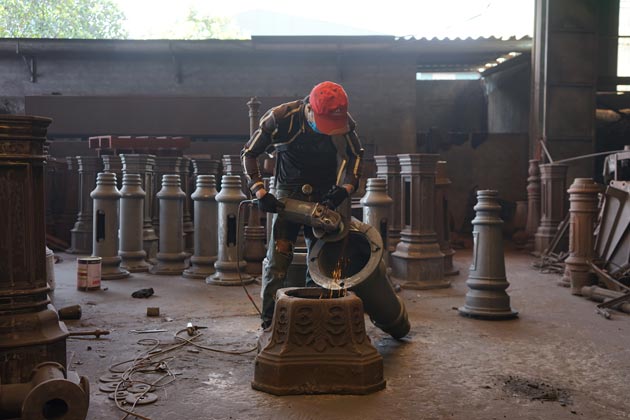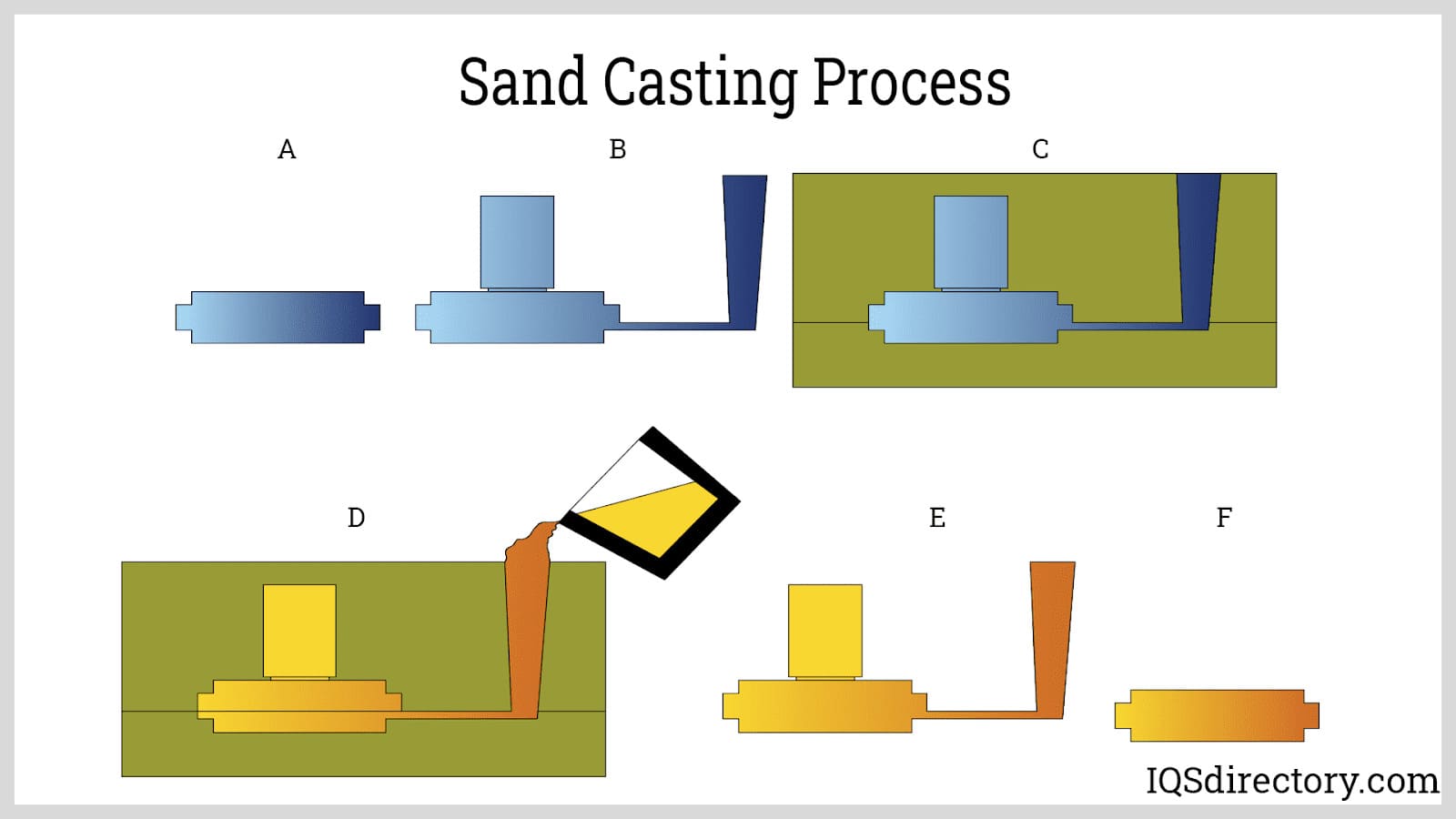Aluminum Foundry Wisconsin drives sustainable casting practices
Just How Aluminum Foundry Adds to Improvements in Aerospace Engineering
Aluminum shops are integral to advancements in aerospace design. They generate lightweight, high-strength elements that are necessary for contemporary aircraft. With innovative spreading strategies, these factories create complex geometries that boost structural stability. Furthermore, the development of exceptional Aluminum alloys sustains the sector's concentrate on gas efficiency and sustainability. However, challenges continue to be in the production procedure. Understanding these factors reveals the profound impact of Aluminum on aeronautics's future.
The Relevance of Lightweight Products in Aerospace Layout
As the aerospace industry remains to develop, the value of light-weight products comes to be progressively obvious. The demand for efficiency and sustainability drives designers to prioritize using products that reduce overall weight without endangering architectural stability. Light-weight materials, especially Aluminum, play a crucial role in enhancing gas efficiency, boosting payload capability, and raising the general efficiency of aircraft.
The assimilation of these products enables for ingenious layouts, allowing manufacturers to develop even more wind resistant forms that can endure extreme conditions. The decrease in weight not just reduces functional expenses however likewise adds to a lowered ecological impact, lining up with worldwide efforts towards sustainability in aviation.
Advanced Casting Techniques in Aluminum Foundries
Advanced spreading strategies in Aluminum shops play an essential function in aerospace engineering by making it possible for the manufacturing of accurate and light-weight components. Developments in mold and mildew layout and accuracy casting procedures are important in attaining ideal efficiency and architectural integrity. In addition, the development of light-weight alloys enhances the general efficiency and effectiveness of aerospace applications.
Innovative Mold Layout
Innovative mold and mildew design plays an important function in the performance and effectiveness of Aluminum foundries, especially within the aerospace market. By leveraging advanced products and techniques, modern-day mold and mildews can be engineered to hold up against heats and pressures, making sure peak performance throughout the casting procedure. These designs commonly include intricate geometries that allow for the manufacturing of lightweight yet structurally audio components, necessary for aerospace applications. In addition, making use of computer-aided design (CAD) software application helps with exact modeling, making it possible for foundries to refine and imitate mold and mildew styles prior to physical production starts. This not only boosts the quality of cast parts yet likewise minimizes waste and preparation, leading to considerable cost savings. On the whole, innovative mold and mildew design is a keystone of progression in Aluminum Foundry modern technology for aerospace design.
Precision Casting Procedures
The efficiency of innovative mold layouts perfectly incorporates with accuracy spreading processes, which are essential for creating top quality Aluminum elements in aerospace design. These procedures, including sand spreading, die spreading, and financial investment spreading, guarantee the production of intricate geometries with tight resistances. Advanced techniques like vacuum spreading and stress die casting boost the honesty and surface area finish of the end products. Accuracy casting reduces material waste while taking full advantage of the mechanical buildings of Aluminum, critical for aerospace applications. Additionally, utilizing real-time monitoring and progressed simulation devices throughout the spreading procedure allows for immediate adjustments, bring about enhanced high quality control. Collectively, these accuracy casting procedures placement Aluminum factories at the forefront of aerospace technology, sustaining the sector's need for reliability and performance.
Lightweight Alloy Advancement
As aerospace engineers seek to boost gas effectiveness and performance, light-weight alloy growth ends up being a vital emphasis in Aluminum factories. These foundries employ sophisticated spreading methods to create alloys that offer exceptional strength-to-weight ratios. Technologies in alloy structure, consisting of the incorporation of aspects like lithium and magnesium, allow the manufacturing of products that withstand extreme conditions while decreasing overall airplane weight. Strategies such as die spreading and financial investment spreading assist in the precision manufacturing of complex shapes, which are critical for aerospace applications. Additionally, recurring research study aims to optimize these alloys for improved mechanical residential properties and raised sturdiness. By prioritizing lightweight alloy advancement, Aluminum factories significantly add to the evolution of aerospace engineering, leading the way for much more effective and lasting aircraft styles.

Enhancing Structural Stability With Aluminum Components
Aluminum components use significant advantages in improving architectural integrity within aerospace design. Their light-weight nature adds to total effectiveness while preserving toughness, which is essential for aircraft efficiency. Additionally, the stress and anxiety resistance residential properties of Aluminum aid guarantee the durability and dependability of aerospace structures under different functional problems.
Lightweight Material Conveniences
While conventional products typically compromise weight for strength, making use of Aluminum elements in aerospace design provides considerable advantages in architectural honesty. Aluminum's lightweight nature adds to general style effectiveness, permitting even more streamlined aircraft that eat much less fuel, therefore boosting sustainability. The material's excellent strength-to-weight ratio warranties that parts preserve sturdiness without including unneeded mass. This quality fosters improved efficiency and agility in flight, along with maximized payload abilities. In addition, Aluminum's resistance to rust lengthens the life-span of aerospace frameworks, decreasing maintenance prices and boosting safety. As suppliers significantly adopt Aluminum alloys, the aerospace sector experiences a transformative change towards extra reliable and reliable engineering solutions that prioritize both efficiency and ecological obligation.
Anxiety Resistance Qualities
Although numerous materials possess distinct buildings, Aluminum's exceptional tension resistance stands out as an essential consider boosting the architectural honesty of aerospace elements. This resistance plays a critical read here role in ensuring that aircraft can stand up to various functional stresses, consisting of exhaustion, influence, and environmental conditions. Aluminum alloys, especially crafted for aerospace applications, display high tensile strength while keeping lightweight attributes, enabling engineers to create a lot more effective structures - Aluminum Foundry. In addition, the capability of Aluminum to endure cyclic loading without considerable contortion adds to the longevity and reliability of aerospace components. As developments continue in Aluminum Foundry techniques, the growth of stress-resistant Aluminum components guarantees more enhancements in efficiency, safety and security, and performance across the aerospace sector, strengthening Aluminum's duty as a preferred material in contemporary design
Gas Performance Improvements Driven by Aluminum Innovations
As the aerospace market seeks to enhance fuel performance, innovative uses Aluminum have emerged as a vital remedy. Aluminum's light-weight nature significantly lowers aircraft weight, permitting reduced fuel intake during trip. This decrease in weight is vital, as also tiny reductions can lead to substantial enhancements in overall fuel economy.
Advanced Aluminum alloys, designed for enhanced strength and resilience, enable manufacturers to develop elements that maintain structural stability while minimizing mass - Aluminum Foundry. Additionally, the integration of Aluminum in airframes and engine parts assists in improved aerodynamics, adding to minimized drag and enhanced efficiency
The fostering of Aluminum in aerospace not just fulfills the demand for fuel-efficient layout but likewise aligns with governing stress for lower discharges. As these innovations remain to advance, they play a significant function in establishing new criteria for gas performance, making certain that the aerospace field can fulfill expanding financial and environmental challenges.

The Function of Aluminum in Sustainable Air Travel Practices
The increasing emphasis on sustainable aviation methods has positioned Aluminum as a vital material in the mission for greener aircraft style. Recognized for its lightweight residential properties, Aluminum significantly reduces airplane weight, bring about lower gas usage and emissions. Its recyclability better improves its sustainability profile, as Aluminum can be reused forever without loss of quality. This particular sustains a circular economic climate within the air travel field, decreasing waste and resource deficiency.
Furthermore, advancements in Aluminum alloys have improved their toughness and corrosion resistance, enabling longer life span and lowered upkeep needs. These advancements assist in the growth of much more reliable airplane frameworks, adding to general sustainability initiatives. In addition, Aluminum's thermal conductivity plays a critical function in energy-efficient layouts, improving systems such as warmth exchangers. Collectively, these features emphasize Aluminum's critical duty beforehand sustainable aviation, lining up with international initiatives targeted at minimizing the environmental impact of flight.
Difficulties Faced by Aluminum Foundries in Aerospace Manufacturing
While Aluminum factories play a crucial duty in aerospace manufacturing, they encounter substantial obstacles that can influence manufacturing effectiveness and high quality. One significant difficulty is the rigorous quality control criteria required in the aerospace market. Any flaw can endanger safety and security and efficiency, demanding strenuous get more evaluation processes that prolong manufacturing timelines. Additionally, factories commonly emulate rising and fall raw material prices, which can affect pricing and success. The intricacy of Aluminum alloys used in aerospace applications additional makes complex the production procedure, as specific formulations are essential for accomplishing desired mechanical residential properties. Furthermore, skilled labor lacks hinder the capability to preserve top notch manufacturing degrees. Ultimately, environmental guidelines enforce constraints on emissions and waste management, needing factories to buy sustainable techniques, which can be cost-prohibitive. These elements collectively create a landscape where Aluminum factories need to continuously adjust to meet the advancing demands of aerospace manufacturing while making sure security and conformity.
Future Trends in Aluminum Applications for Aerospace Design
With improvements in innovation and boosting needs for effectiveness, the future of Aluminum applications in aerospace design is positioned for significant improvement. The assimilation of innovative Aluminum alloys and compounds is anticipated to boost strength-to-weight ratios, resulting in even more fuel-efficient airplane designs. Furthermore, innovations in additive production strategies will certainly enable the production of complex Aluminum structures that were previously difficult, maximizing efficiency and minimizing waste.

Sustainable practices will play a necessary duty, with an expanding emphasis on recycling Aluminum to reduce environmental influence. The aerospace sector is most likely to welcome smarter producing processes, such as automation and expert system, making certain higher top quality and accuracy in Aluminum components. Furthermore, cooperations in between Aluminum shops and aerospace companies will cultivate research study and growth, paving the means for brand-new applications that meet the strict needs of modern-day aerospace engineering - Aluminum Foundry. In general, the future looks guaranteeing for Aluminum's duty in forming the skies
Regularly Asked Questions
What Are the Ecological Effects of Aluminum Production in Aerospace?
The environmental impacts of Aluminum manufacturing in aerospace consist of considerable power usage, greenhouse gas exhausts, and habitat interruption. Furthermore, mining procedures can bring about soil degradation and water contamination, increasing problems regarding sustainability and eco-friendly balance.
Exactly How Does Aluminum Contrast to Other Materials in Aerospace Applications?
Aluminum uses an one-of-a-kind mix of light-weight properties, deterioration resistance, and cost-effectiveness compared to other products. Its high strength-to-weight proportion makes it especially useful for aerospace applications, boosting fuel performance and total performance in aircraft layout.
What Certifications Do Aluminum Foundry Workers Requirement for Aerospace Projects?
Aluminum Foundry workers require specific training in metallurgy and casting techniques, along with expertise of aerospace market requirements. Accreditations in top quality control and security protocols are additionally crucial to guarantee conformity with rigid aerospace job requirements.
Are There Any Security Problems With Making Use Of Aluminum in Aerospace Engineering?
Safety worries relating to Aluminum in aerospace engineering include sensitivity to tiredness, rust, and anxiety fractures. Appropriate treatment and alloy choice are necessary to alleviate these threats, guaranteeing architectural honesty and general security in aerospace applications.
Just How Does Aluminum Recycling Advantage the Aerospace Industry?
Aluminum recycling substantially benefits the aerospace market by reducing material costs, lessening ecological impact, and preserving power. This sustainable technique boosts the market's effectiveness while promoting making use of light-weight, high-performance elements in aircraft production.
Advanced spreading strategies in Aluminum shops play an essential function in aerospace design by enabling the production of accurate and light-weight parts. Innovative mold style plays a vital duty in the performance and effectiveness of Aluminum shops, particularly within the aerospace field. As aerospace designers seek to boost fuel performance and performance, lightweight alloy growth becomes an essential emphasis in Aluminum shops. Aluminum alloys, specifically crafted for check aerospace applications, exhibit high tensile stamina while preserving lightweight qualities, allowing engineers to design extra reliable structures. Cooperations between Aluminum foundries and aerospace business will promote research and advancement, paving the method for brand-new applications that satisfy the stringent needs of modern aerospace engineering.